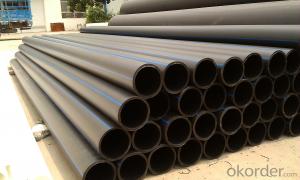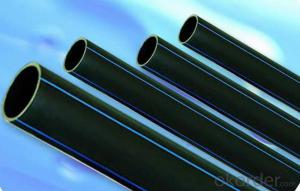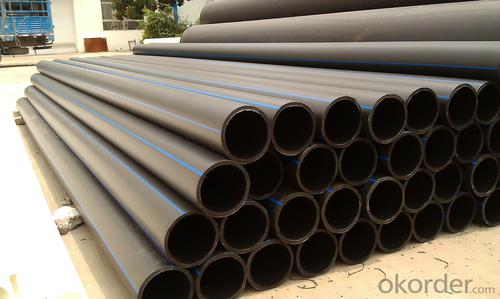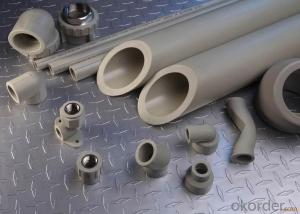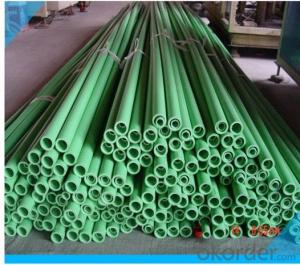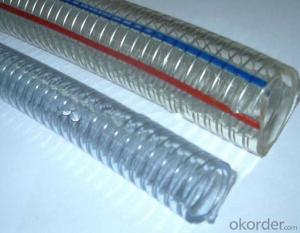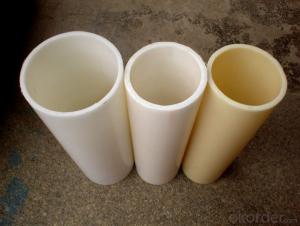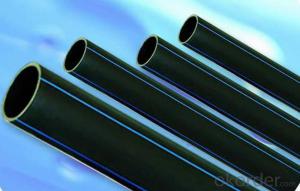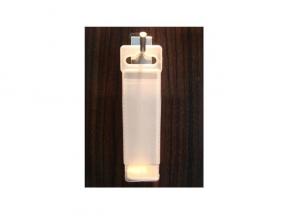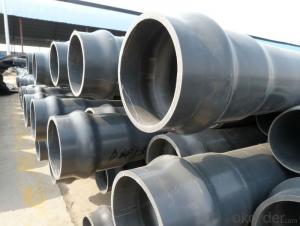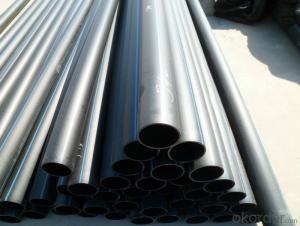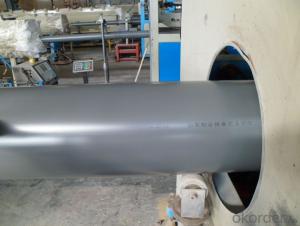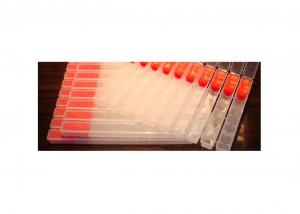Plastic Tubes HDPE Pipe ISO4427-2000 DN280
- Loading Port:
- China Main Port
- Payment Terms:
- TT OR LC
- Min Order Qty:
- -
- Supply Capability:
- -
OKorder Service Pledge
OKorder Financial Service
You Might Also Like
Physical properties[edit]
Polyethylene is a thermoplasticpolymer consisting of long hydrocarbon chains. Depending on the crystallinity and molecular weight, a melting point and glass transition may or may not be observable. The temperature at which these occur varies strongly with the type of polyethylene. For common commercial grades of medium- and high-density polyethylene the melting point is typically in the range 120 to 180 °C (248 to 356 °F). The melting point for average, commercial, low-density polyethylene is typically 105 to 115 °C (221 to 239 °F).it is transprant.
Chemical properties[edit]
Most LDPE, MDPE and HDPE grades have excellent chemical resistance, meaning that it is not attacked by strong acids or strong bases. It is also resistant to gentle oxidants and reducing agents. Polyethylene burns slowly with a blue flame having a yellow tip and gives off an odour of paraffin. The material continues burning on removal of the flame source and produces a drip.[3] Crystalline samples do not dissolve at room temperature. Polyethylene (other than cross-linked polyethylene) usually can be dissolved at elevated temperatures in aromatic hydrocarbons such as toluene or xylene, or in chlorinated solvents such as trichloroethane or trichlorobenzene.[4]
GB/T13663-2000:
| PE63管材规格 | |||||
| 公称 外径dn,mm | SDR33 | SDR26 | SDR17.6 | SDR13.6 | SDR11 |
| 公称压力 PN,Mpa | |||||
| 0.32 | 0.4 | 0.6 | 0.8 | 1.0 | |
| 公称 壁厚 | 公称 壁厚 | 公称 壁厚 | 公称 壁厚 | 公称 壁厚 | |
| 16 | 2.3 | ||||
| 20 | 2.3 | 2.3 | |||
| 25 | 2.3 | 2.3 | 2.3 | ||
| 32 | 2.3 | 2.4 | 2.9 | ||
| 40 | 2.3 | 2.3 | 3.0 | 3.7 | |
| 50 | 2.3 | 2.9 | 3.7 | 4.6 | |
| 63 | 2.3 | 2.5 | 3.6 | 4.7 | 5.8 |
| 75 | 2.3 | 2.9 | 4.3 | 5.6 | 6.8 |
| 90 | 2.8 | 3.5 | 5.1 | 6.7 | 8.2 |
| 110 | 3.4 | 4.2 | 6.3 | 8.1 | 10.0 |
| 125 | 3.9 | 4.8 | 7.1 | 9.2 | 11.4 |
| 140 | 4.3 | 5.4 | 8.0 | 10.3 | 12.7 |
| 160 | 4.9 | 6.2 | 9.1 | 11.8 | 14.6 |
| 180 | 5.5 | 6.9 | 10.2 | 13.3 | 16.4 |
| 200 | 6.2 | 7.7 | 11.4 | 14.7 | 18.2 |
| 225 | 6.9 | 8.6 | 12.8 | 16.6 | 20.5 |
| 250 | 7.7 | 9.6 | 14.2 | 18.4 | 22.7 |
| 280 | 8.6 | 10.7 | 15.9 | 20.6 | 25.4 |
| 315 | 9.7 | 12.1 | 17.9 | 23.2 | 28.6 |
| 355 | 10.9 | 13.6 | 20.1 | 26.1 | 32.2 |
| 400 | 12.3 | 15.3 | 22.7 | 29.4 | 36.3 |
| 450 | 13.8 | 17.2 | 25.5 | 33.1 | 40.9 |
| 500 | 15.3 | 19.1 | 28.3 | 36.8 | 45.4 |
| 560 | 17.2 | 21.4 | 31.7 | 41.2 | 50.8 |
| 630 | 19.3 | 24.1 | 35.7 | 46.3 | 57.2 |
- Q: Hot melt connection method of PE-RT plastic pipe and the matters needing attention
- 1 hot melt tools connected to the power, to reach the working temperature indicator light, you can start the operation;2 cutting pipe must be made perpendicular to the end of the pipe line. The general use of the pipe or pipe cutting shear pipe cutting machine, if necessary, use a sharp saw, but after cutting the pipe section should remove burrs and burrs;3 the end face of pipe and pipe must be clean, dry and oil-free;4 use calipers and suitable pens to measure and mark the depth of hot melt at the end of the tube.
- Q: Are plastic tubes resistant to mold and mildew?
- Yes, plastic tubes are generally resistant to mold and mildew.
- Q: What are the common applications of plastic tubes in the construction industry?
- Plastic tubes are commonly used in the construction industry for various applications such as plumbing, electrical conduit, drainage systems, and ventilation ducts.
- Q: How do plastic tubes compare to fiberglass tubes in terms of weight?
- Plastic tubes are generally lighter in weight compared to fiberglass tubes.
- Q: Can plastic tubes be used for automotive applications?
- Yes, plastic tubes can be used for automotive applications. They are commonly used for various purposes such as fuel lines, coolant hoses, vacuum lines, and air intake systems. Plastic tubes offer benefits like durability, flexibility, resistance to chemicals and heat, and cost-effectiveness, making them suitable for automotive use.
- Q: The inner and outer walls are plastic, and the middle layer is steel
- Is this the wire mesh plastic (polyethylene) composite pipe?,Steel mesh skeleton plastic composite pipe with high strength steel wire mesh skeleton about forming spiral winding reinforced high density polyethylene (HDPE) as the substrate, and the wire skeleton inside and outside layer of high density polyethylene tightly connected together with adhesive resin layer with high performance.
- Q: Are plastic tubes suitable for use in the automotive fuel system?
- No, plastic tubes are generally not suitable for use in the automotive fuel system.
- Q: Two identical strong magnets are dropped simultaneously by two students into two vertical tubes of the same dimensions (see figure below). One tube is made of copper, and the other is made of plastic.
- hi Ducky, Hehehehehehehehehehehehehehehehehehehehe... i admire this one..the place IS GOD!!! which will coach those boys a element or 2..a huge celeb My pal.. a chum, poppy1 happy Easter My friends. a especially Easter Egg for Me. Lol..
- Q: Can plastic tubes be used for electric wire protection in outdoor applications?
- Yes, plastic tubes can be used for electric wire protection in outdoor applications. Plastic tubes, such as PVC or polyethylene, are commonly used due to their durability, resistance to weather conditions, and ability to protect wires from moisture, UV rays, and physical damage. However, it is important to choose the appropriate type and thickness of plastic tube based on the specific requirements and environmental conditions of the outdoor application.
- Q: Can plastic tubes be used for gardening?
- Yes, plastic tubes can be used for gardening. They can be used as containers for growing plants, as irrigation systems, or for protecting young plants.
Send your message to us
Plastic Tubes HDPE Pipe ISO4427-2000 DN280
- Loading Port:
- China Main Port
- Payment Terms:
- TT OR LC
- Min Order Qty:
- -
- Supply Capability:
- -
OKorder Service Pledge
OKorder Financial Service
Similar products
Hot products
Hot Searches
Related keywords
